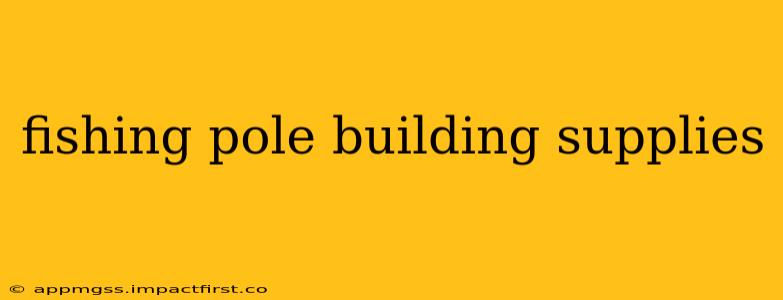Building your own fishing rod is a rewarding experience, allowing you to customize every aspect to perfectly match your fishing style and preferences. This guide provides a comprehensive overview of the essential fishing pole building supplies you'll need, from blanks to guides and everything in between. Whether you're a seasoned rod builder or a curious beginner, this resource will equip you with the knowledge to embark on your custom rod-building journey.
What are the Basic Fishing Pole Building Supplies?
The fundamental supplies for building a fishing rod can be grouped into several categories:
-
Rod Blanks: These are the foundation of your rod, providing the structure and backbone. The blank's material (graphite, fiberglass, or composite) dictates the rod's action, power, and weight. Consider the type of fishing you’ll be doing (bass, trout, saltwater, etc.) to choose the appropriate blank.
-
Guides: These ceramic rings direct the fishing line smoothly along the rod, reducing friction and improving casting distance and accuracy. The type and size of guides will vary depending on the rod's length, power, and line type. Consider single-foot or double-foot guides based on your preferences and the line weight.
-
Reel Seat: This component secures the fishing reel to the rod. Many different types are available, varying in material (graphite, aluminum, cork), design, and locking mechanisms. Choose a reel seat compatible with the size and type of reel you plan to use.
-
Grip/Handle: This provides a comfortable and secure grip while fishing. Popular materials include cork, EVA foam, and combinations thereof. Cork offers a classic feel, while EVA foam provides a more durable and often less expensive alternative.
-
Epoxy Resin & Hardener: This is crucial for bonding all the components together. High-quality epoxy ensures a strong and durable bond, crucial for the longevity of your custom rod. Careful mixing according to manufacturer instructions is paramount for proper curing.
-
Thread: Used to wrap the guides and reel seat securely to the rod blank. Various colors and thicknesses are available, allowing for aesthetic customization. A good quality thread is vital for a durable and visually appealing finished product.
-
Finishing Materials: These are used to protect the rod and enhance its appearance. This typically includes a finish coat of epoxy or a specialized rod finish. This provides protection from the elements and gives a professional look.
What Tools Do I Need for Building a Fishing Pole?
Beyond the materials, specific tools are needed for successful rod building:
-
Rod Building Vise: Securely holds the rod blank during the building process, allowing for precise guide placement and wrapping.
-
Guide Wrapping Tools: These include a bobbin for dispensing thread smoothly, a heat gun for setting the epoxy, and possibly a varnish or finish applicator.
-
Epoxy Mixing Cups & Sticks: For accurately measuring and mixing the epoxy resin and hardener.
-
Measuring Tools: A ruler or measuring tape for accurate guide spacing.
-
Sandpaper: For smoothing the rod blank before applying the finishing coats.
What Kind of Rod Blank Should I Choose?
The choice of rod blank significantly impacts the final product's performance. Factors to consider include:
-
Material: Graphite blanks are lightweight and sensitive, while fiberglass blanks are more durable and forgiving. Composite blanks blend the properties of both.
-
Action: This describes how the rod bends under load. Fast action rods bend primarily in the tip, while slow action rods bend along their entire length.
-
Power: This refers to the rod's ability to lift and control fish. Power ratings range from ultra-light to extra-heavy.
How Much Does It Cost to Build a Fishing Rod?
The cost varies greatly depending on the materials chosen. A basic rod can be built for under $100, while high-end components can easily push the cost well over $200.
Where Can I Find Fishing Pole Building Supplies?
Numerous online retailers and specialized rod-building shops offer a wide selection of supplies. It's advisable to research different suppliers to compare prices and product quality.
Are There Any Specific Tips for Beginners Building a Fishing Pole?
Beginners should start with a simple rod design and high-quality materials. Practice on scrap blanks before working on your final project. Follow detailed instructions meticulously, and don't rush the process. A slow, deliberate approach will yield better results.
By carefully selecting your fishing pole building supplies and following best practices, you can create a custom rod that meets your exact specifications and provides years of enjoyable fishing experiences. Remember to consult detailed tutorials and videos for visual guidance throughout the process. Happy building!
